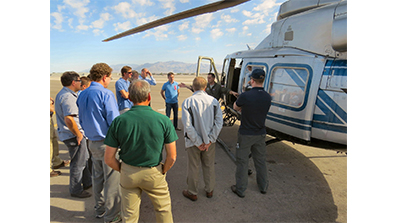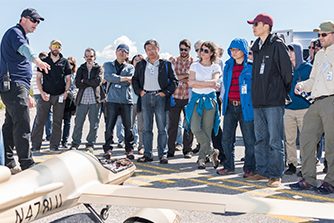Remote Sensing Laboratory Aerial Measuring System promotes international partnerships and aerial radiological response capabilities worldwide
Following the attacks of Sept. 11, 2001, radiological aerial training requirements among local, state and federal agencies came to the forefront of the nation’s nuclear incident response mission. The U.S. Department of Energy (DOE) and Department of Homeland Security’s Domestic Nuclear Detection Office created the Aerial Measuring System (AMS) Reach-Back Center to provide training and assistance for all aspects of radiological aerial measurement. The AMS mission is to provide a rapid survey of radiation and contamination following a radiological emergency and to provide baseline radiation surveys in advance of major events. Based out of the Nevada National Security Site’s (NNSS) Remote Sensing Laboratory (RSL) at Nellis Air Force Base and Joint Base Andrews, the AMS team has developed the resources to train agencies nationwide and collaborate with AMS organizations internationally.
In 2014, the RSL AMS team held its first WINGS exercise, bringing participants together to see firsthand how science, aviation and flight operations come together to protect the nation. Held again in 2015 and 2016 in different U.S. cities, the exercises involved more than 100 representatives participating in a full-scale drill to conduct contamination mapping with real assets and aircraft. The events served as a premier opportunity for attendees to practice interagency coordination and experience varying systems, equipment and techniques.
Following the success of the WINGS exercises, AMS’ outreach further evolved through the National Nuclear Security Administration (NNSA)’s Office of Nuclear Incident Policy and Cooperation following the United States’ assistance with the Fukushima nuclear disaster in 2011. An international symposium at the NNSA’s Nevada Field Office called for an alliance of international expertise on responding to nuclear incidents, resulting in the AMS International Technical Exchange Program, which debuted in 2013.
Having completed its seventh annual session May 13 to 16, 2019, the forum allows AMS representatives from participating nations to share the programmatic and technological developments in their respective countries. Each year features a different theme.
The 2019 session centered on training and exercise topics, which include the coordination process with city, state and federal agencies; software and operations systems; and personnel roles. Representatives from Brazil, Canada, the Czech Republic, Denmark, France, Iceland, Japan, Korea, Sweden and Taiwan attended the Technical Exchange, held in North Las Vegas. Featured presentations included updates by the participating nations, data training simulations and demonstrations of a Bell 412 helicopter and radiation detection system.
Windy City procedures
This year’s International Technical Exchange examined training events in Chicago, which boasts a strong AMS presence, to show how the United States utilizes AMS at a regional level.
As it does for national-level events in cities throughout the country, NNSS’ RSL team supports major events in Chicago through the Radiological Assistance Program’s (RAP) Region 5 – one of nine geographic RAP regions across the United States. In addition to aerial surveying, the program conducts ground-based monitoring through backpack equipment, portal monitoring and venue sweeps. RAP 5 is made up of 10 states in the Midwest, which include seven of the largest 50 cities in the country and 26 nuclear power reactors.
AMS’ training partnership with Chicago began in January 2008 at the request of city police. Chicago was the first recipient of AMS’ Mobile Aerial Radiological Surveillance (MARS) course, which involves classroom and tactical exercises.
“They wanted to do radiation detection flights for special events and inquired about radiation detection equipment,” said Frank Moore, RAP 5 principal scientist and equipment coordinator.
AMS educated city emergency response officials about the aerial logistics involved in event organization. These include mission overviews and planning, radiological threats and aerial detection.
Notable events in Chicago that have called upon RAP 5’s capabilities include parades and marathons , political conventions, World Series games and the Chicago Cubs’ World Series victory rally at Grant Park, which involved millions of attendees. Data from RAP 5 surveys for those and other events are provided back to the city of Chicago.
RAP 5 also covers more than 1,000 border miles with Canada. RAP 5 has a longstanding partnership with Customs and Border Protection – conducting training and exercise flights with the agency using simulated release and deposition data.
“A lot of the equipment translates from our folks’ day jobs,” Moore said. “The ability to do training with simulated data is outstanding.”
Training involves an intricate choreography of system installation on the aircraft, mission planning and flight pattern coordination, in-flight system operations, scientist-pilot communications, map products, and data retrieval and analysis.
Navigating nationwide
Another area featured during the International Technical Exchange was federal response simulations in the Unites States. AMS coordinates with federal agencies to conduct stress test responses in major cities, which utilize military aerial assets and field teams along with AMS capabilities. Occurring twice a year in different cities, the full-scale exercises involve the U.S. Department of Defense (DOD), and Department of Justice in addition to NNSA’s Office of Nuclear Forensics and the AMS, RAP and consequence management teams.
Alternating the scenario location with each rotation allows agencies to plan for a multitude of outlying factors, from congested airspace to geographic challenges.
“This mainly focuses on federal response to a nuclear weapons incident,” said RSL AMS Senior Scientist Dan Haber. “It tests the ability of DOD and DOE assets to deploy from their respective home bases to a major U.S. city. AMS is more of an enabler to this exercise. AMS provides the data to the players so they can make their decisions.”
As the players execute their roles, AMS provides data to the participants so that they can determine ideal sample locations. Samples are transferred to the DOE National Laboratories, and data is provided back to the modelers for further refinement.
A united front
For those in the AMS field, the International Technical Exchange is an opportunity to benchmark best practices from other nations.

“This allows a lot of connections with other countries,” said RSL-Nellis AMS Manager Piotr Wasiolek, who has led the NNSS’ AMS efforts for 20 years. “This is an exchange of ideas from people who do this work every day.”
While the participating nations are in various stages of their AMS development, the International Technical Exchange allows for collective input for future sessions. At the end of each meeting, the team provides input for the following year’s theme.
“Ten years ago, I insisted we should have AMS capability. The AMS team is very important in a radiological emergency. I take [this information] back to my country and share this meeting,” said BJ Kim, a third-year participant with the Republic of Korea’s Institute of Nuclear Safety.
From supporting the Fukushima response to the present-day International Technical Exchange, RSL AMS holds a legacy of teaming with other nations for greater radiological response and safety measures worldwide.
“The collaboration between Helinuc (France’s AMS) and the American AMS is historical, as we were the first foreign team to work with AMS in a joint survey over NNSS,” said Marine Wansek, a second-year participant with the French Alternative Energies and Atomic Energy Commission. “The objective of participating with the AMS International Technical Exchange is to maintain contact with foreign countries and to learn from each other. From this year’s Technical Exchange, it is clear that training and exercises are fundamental to maintain teams’ readiness for the AMS mission.”
For more information about RSL’s work in homeland security and counterterrorism, visit https://www.nnss.gov/pages/facilities/RSL.html.

